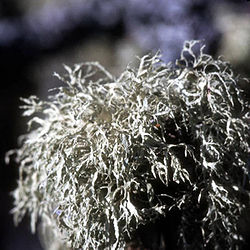Reindeer lichen
| Reindeer lichen |
|---|

|
| Scientific Classification |
|
| Binomial Name |
|
Cladina rangiferina |
Reindeer lichen is a species of lichen given the scientific name Cladina rangiferina. Although its morphology contains structures that resemble antlers, its name is derived from the fact that it is one of reindeer's and caribou's primary food sources. The lichen's highly branched growth pattern is similar in appearance to moss, causing it to also be known as Reindeer moss and Caribou moss. Cladina rangiferina is easily distinguished from related species by its color, and does not have the hard, shiny outer surface possessed by relatives.
Like other lichens, it is a symbiotic organism - a combination of a fungus and an algae. It exists in extreme environmental habitats due to the successful combination of attributes. The mycobiont fungus provides moisture and minerals, and the photobiont alga provides photosynthetic nutrition. The reindeer lichen is circumpolar, which means it exists around the earth's poles.
Anatomy
The reindeer lichen is a shrub lichen which is 5-8 cm. tall[1]. They are usually greyish white, and branch from a main stem. The branches are hollow, with a dull cottony surface. Many of the end branchlets are pointed in one direction, like they were swept side to side. A lichen consists of a fungus and either a alga or a cyanobacterium. These two organisms live together symbiotically, forming a composite organism[2]. A reindeer lichen is considered to be a fruticose, which means it is bushy and branched. This growth pattern is similar to moss. The generic name Cladonia comes from the Greek word kladon which means "sprout" to signify the shrub-like appearance of the branching segments of the plant. The species name rangiferina is taken from the reindeer/caribou genus called Rangifer. Reindeer lichen have hollow stocks called podetia which extend from the granular crustose thallus at the base in branches.
Reproduction
Reindeer lichen grow very slow, and a mature clump could be around 100 years old. The reindeer lichen produce a new branch about each new year. You would be able to estimate the reindeer lichen's age if you counted back along the major branchings along the stem. Around twenty years the lower parts of the reindeer lichen start to decompose. The periods that reindeer lichen grow the most are spring and fall when cool temperatures and high humidity prevail[3]. The reindeer lichen reproduce asexually. The reindeer lichen undergoes vegetative regeneration, a form of asexual reproduction in which portions of the older existing growth (vegetation) provide the genetics for copying and replication. Lichens in the Cladonia genus undergo regeneration by forming small balls of fungal hyphae called soredia that enclose several algal cells[4]. The soredia are dispersed just like the spores of a fungus are dispersed, which are wind, water, animals, and humans. Once the reindeer lichen is established in its new spot, it grows around 8mm per year, which is very slow. Reindeer lichen also reproduce by fragmentation.
Ecology
The reindeer lichen is found on alkaline soils, and among open vegetation. This lichen can also be found in the Arctic, and some north temperate regions. Reindeer and caribou eat it, therefore it must thrive in cold places and forests where these animals are found. Sometimes it forms carpets in open coniferous forests, and is common on sandy soil. It thrives in open sites like bogs and tundra[5]. Some stress studies were done on the reindeer lichen, and it was found that only boiling and radiation caused severe injuries to them[6]. Some of the places that reindeer lichens have been found are Turkey, western parts of France, North Africa, Canary Isles, Cornwall, and in Britain. The lichen mats that lay on the boreal forest regions floor intercept rain fall and make it so that no other plant from the outside can grow seedlings where they are[7]. There are four species of reindeer lichen that are predominate in boreal forests are C. rangiferina, C. arbuscula, C. mitis, and C. stellaris. This article is on the C. rangiferina only, which is the most extensive of the four, and is known by its gray-green color.
Uses of Reindeer Lichen
Reindeer lichen has had many different uses and functions. It serves as decoration, food, and medical treatment. Reindeer and caribou eat it to survive. Native people in the north such as Alaska used reindeer lichen in medicinal teas to treat colds, arthritis, fevers and other health problems[8]. They also used it to get rid of intestinal worms[9]. Reindeer lichen was also used as a poultice to soothe arthritis in joints, and has been collected as fodder for cows and livestock. It was believed that it would make the milk creamier of cows, and that their flesh would be fatter and sweeter to the taste. Reindeer lichens have been used also in Scandinavia to manufacture alcohol[10]. Another name for reindeer moss is caribou moss. Reindeer lichen alone do not provide any nutritional benefit to humans, but some native peoples eat partially digested lichen in the stomachs of freshly killed reindeer. This was very beneficial for them providing them with protein and needed nutrients. They sometimes even mixed the digested lichens with meat scraps and blood to make a pudding.
Gallery
Reindeer lichen intermixed with white pine needles.
 Browse |
References
- Classification USDA. 4/19/09.
- Reindeer Lichen Hiker's Notebook. 4/21/09.
- Cladina Reindeer Lichens boreal forest. 4/18/09.



